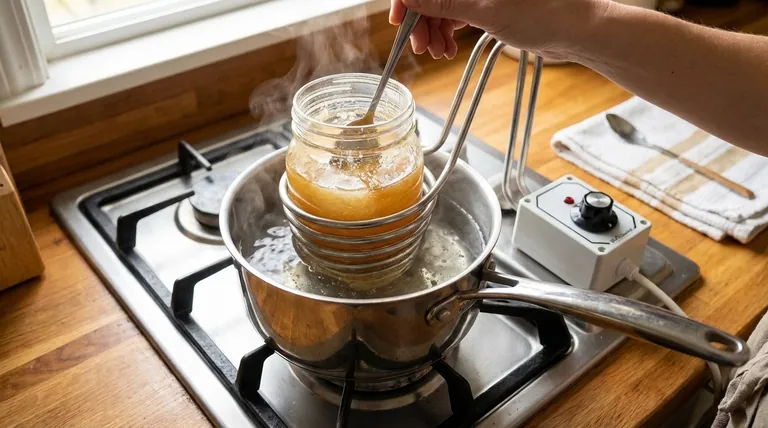To reliquefy crystallized honey, you must gently heat it. The most effective and safest method is to place the honey container in a pan of warm water, allowing the crystals to slowly dissolve back into a liquid state without damaging the honey's delicate flavor and aroma.
Crystallization is a natural and reversible process, not a sign of spoilage. The key to restoring honey's liquid texture is applying low, indirect heat, as high temperatures will degrade its quality by altering its color and taste.

Understanding Why Honey Crystallizes
Before correcting the issue, it's important to understand the cause. Crystallization is not a defect; for many raw and unfiltered kinds of honey, it is a sign of high quality.
A Natural Process, Not Spoilage
Honey is a supersaturated solution of two main sugars: glucose and fructose, dissolved in a small amount of water. Over time, the glucose naturally begins to separate from the water, forming tiny crystals that spread throughout the honey.
The Role of Glucose and Fructose
The speed of crystallization is determined by the ratio of glucose to fructose in the honey, which varies depending on the nectar source. Honeys with a higher glucose content (like clover or dandelion) will crystallize much faster than those with a higher fructose content (like acacia or tupelo).
Triggers for Crystallization
Besides the nectar source, two main factors accelerate this process:
- Temperature: Storage below 65°F (18°C) significantly speeds up crystal formation.
- Particulates: Tiny particles of pollen, wax, or propolis in raw honey act as starting points for crystals to grow.
The Correct Way to Reliquefy Honey
The goal is simple: melt the glucose crystals without "cooking" the honey. This requires patience and gentle heat.
The Warm Water Bath Method
This is the gold standard for preserving honey's quality.
- Place your glass jar of honey, with the lid off, into a pot or pan.
- Fill the pan with warm water until it reaches about halfway up the side of the jar.
- Gently heat the water on the stove over low heat. Do not let the water boil.
- Stir the honey occasionally as it warms to distribute the heat and speed up the process.
- Once the crystals have dissolved, remove the jar and let it cool.
For Plastic Containers
Heating honey in plastic is not ideal, but it can be done with care. Use a bowl of hot tap water rather than direct stovetop heat, as the plastic can warp or leach chemicals if it gets too hot. This method will take longer, and you may need to refresh the hot water.
Understanding the Trade-offs and Pitfalls
Aggressive heating methods are faster, but they come at a significant cost to the quality of the honey.
The Danger of Direct Heat
Never place a jar of honey directly in a pan on the stove. This provides intense, uneven heat that will scorch and caramelize the sugars at the bottom of the jar, permanently altering the flavor and color.
Why Microwaving Is Not Recommended
Microwaving is the fastest way to ruin good honey. It heats extremely rapidly and unevenly, creating super-hot spots that destroy the beneficial enzymes and delicate aromas while leaving other parts of the jar solid.
The Impact of Overheating
Exceeding temperatures of around 110°F (43°C) begins to degrade the honey. The subtle floral notes are the first to disappear, followed by changes in color and the development of a slightly caramelized or burnt taste.
Making the Right Choice for Your Goal
Your approach should depend on your primary objective.
- If your primary focus is preserving maximum quality: Use the slow, gentle warm water bath method on the lowest possible heat setting.
- If your primary focus is convenience: Use a bowl of hot (not boiling) tap water, replacing it as it cools, but understand this is less efficient.
- If you want to prevent future crystallization: Store your honey at a stable room temperature (around 70-80°F or 21-27°C), not in a cold pantry or refrigerator.
By understanding that crystallization is natural, you can easily manage your honey's texture without sacrificing its quality.
Summary Table:
| Method | Best For | Key Consideration |
|---|---|---|
| Warm Water Bath (Stove) | Glass Jars, Preserving Quality | Use low heat; do not boil water. |
| Hot Tap Water Bath | Plastic Containers, Convenience | Slower process; avoid warping plastic. |
| Avoid: Direct Stove Heat/Microwave | All Honey | Destroys flavor, aroma, and enzymes. |
For commercial apiaries and distributors, honey quality is paramount. Properly managing crystallization is essential for maintaining product integrity. HONESTBEE supplies the durable, high-quality beekeeping equipment—like reliable honey warming cabinets and heat-tolerant storage containers—that professionals trust to handle honey gently and efficiently.
Let us help you protect your product's value. Contact our wholesale experts today to discuss equipment solutions tailored to your commercial-scale needs.
Visual Guide

Related Products
- Professional Thermostatic Conical Honey Melter
- Honey Concentrating Vacuum Heating Thickening Machine Dehumidifier for Honey
- 0.5T Capacity Honey Dehumidifier Dryer with Vacuum Heating and Thickening Filtering Machine
- High Quality Honey Dehumidifier Dryer Thickening Machine for Beekeeping
- HONESTBEE 72 Frame Industrial Electric Honey Extractor for Beekeeping
People Also Ask
- What is the effect of heating on honey? Preserve Quality with Controlled Warming
- What is melter honey used for? A Low-Cost Ingredient for Bakers and Brewers
- How to permanently decrystallize honey? Embrace Its Natural State for Maximum Quality
- At what temperature does honey flow? Preserve Quality with the Perfect 95°F Sweet Spot
- Why is it important to heat honey slowly and evenly? Preserve Flavor, Nutrients & Value



















